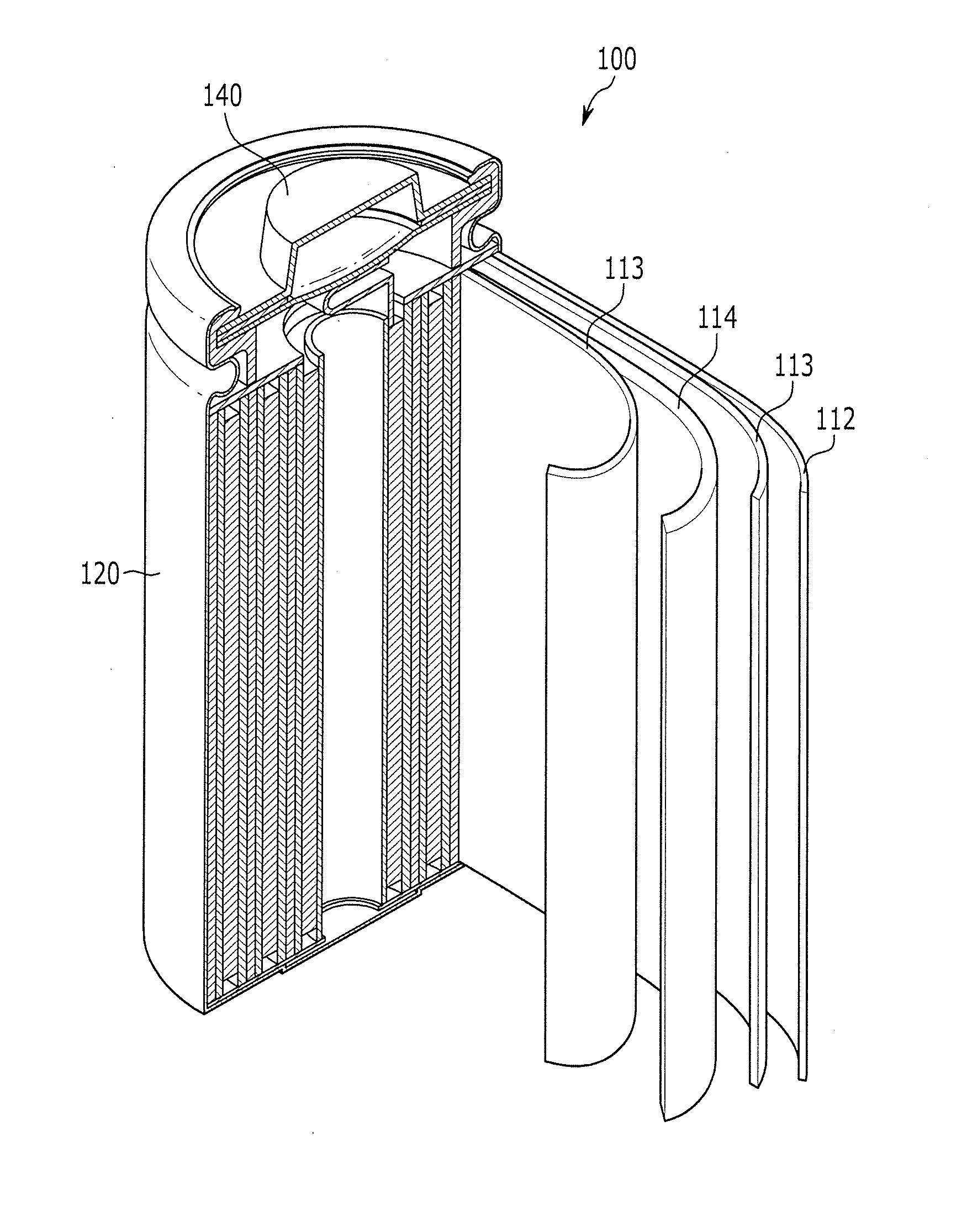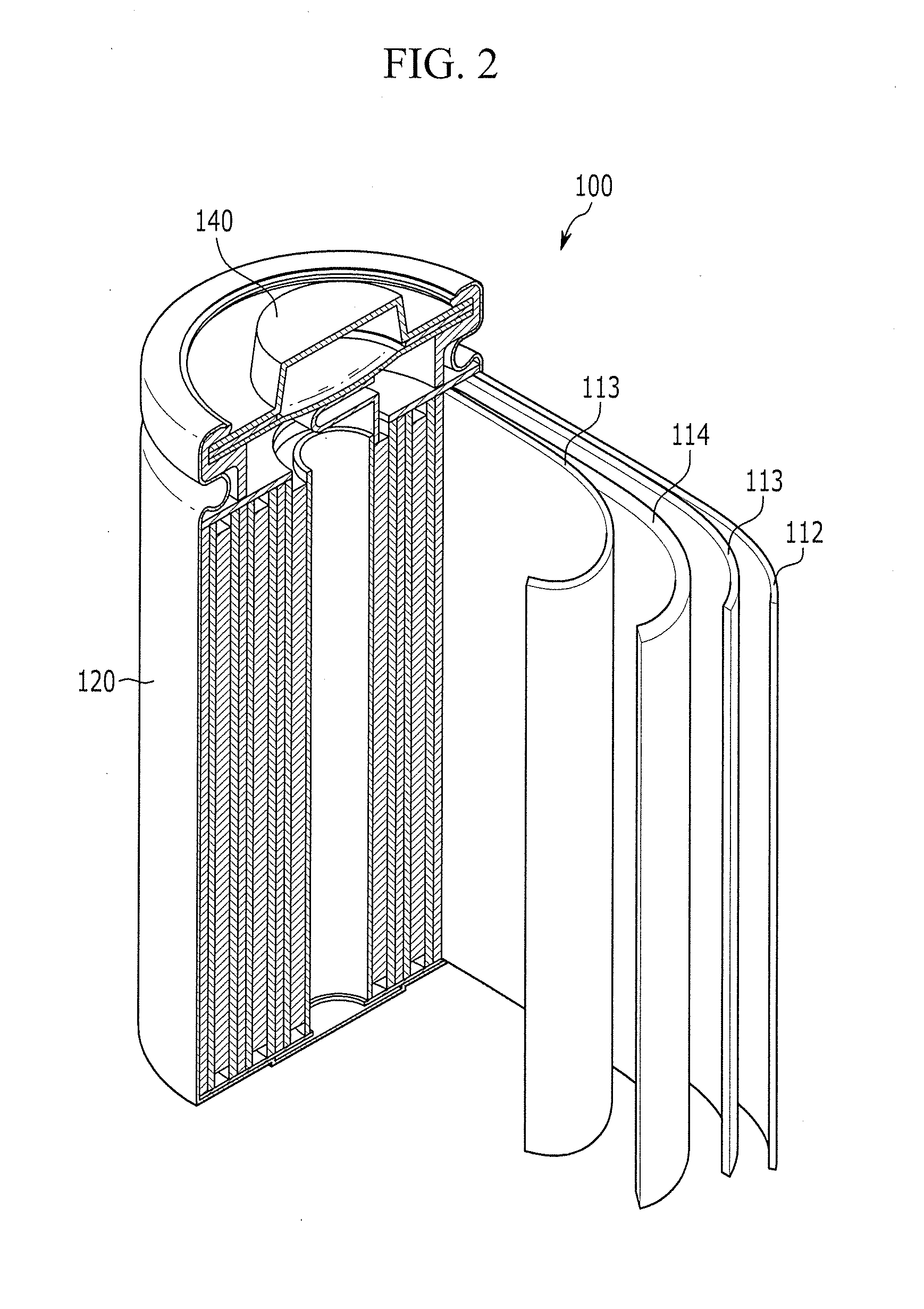Rechargeable lithium battery
a rechargeable lithium battery and lithium battery technology, applied in the direction of non-aqueous electrolyte accumulator electrodes, cell components, electrical apparatus, etc., can solve the problems of limited capacity of carbon-based materials, limited use of carbon-based materials, shortening cycle-life, etc., to improve the cycle-life characteristic of rechargeable lithium batteries, excellent conductivity, and increase the loading level
- Summary
- Abstract
- Description
- Claims
- Application Information
AI Technical Summary
Benefits of technology
Problems solved by technology
Method used
Image
Examples
example 1
[0085]A slurry was prepared by mixing about 4.8 g of LiCoO2 as a positive active material, 0.1 g of polyvinylidenefluoride (PVDF) as a binder, a mixture of about 0.025 g of vapor grown carbon fiber (VGCF) having a diameter of about 0.150 μm, and about 0.075 g of denka black as a conductive material in a solvent of NMP. One side of a 15 μm-thick aluminum current collector was coated with the slurry to have a loading level of about 20 mg / cm2. A positive electrode plate was fabricated by drying the aluminum current collector coated with the slurry in an oven set to about 120° C., and compressing the electrode plate to a plate density of about 3.0 g / cc.
[0086]A coin half cell was fabricated by using metal Li as a negative electrode, including about 0.2 wt % of LiBF4 and about 5 wt % of fluoroethylene carbonate (FEC) as an electrolyte solution, and using ethylenecarbonate (EC) / ethylmethylcarbonate (EMC) / diethylcarbonate (DEC) (at a weight ratio of about 3 / 2 / 5) containing LiPF6 in a concen...
examples 2 to 16
[0087]One side of a 15 μm-thick aluminum current collector was coated with a slurry prepared according to the same method as Example 1 in each of Examples 2 to 16, except that the contents of VGCF and denka black as the conductive materials were changed as presented in the following Table 1 to have loading levels as presented in the following Table 1. Also, in each of Examples 2 to 16, a positive electrode plate was fabricated by drying the aluminum current collector coated with the slurry in an oven set to about 120° C., and compressing the electrode plate to a plate density as presented in the following Table 1.
example 17
[0088]A 18650 cylindrical full cell was fabricated according to the same method as Example 3, except that both sides of a 15 μm-thick aluminum current collector was coated with a slurry having the contents of VGCF and denka black as the conductive materials as presented in the following Table 1 to have a loading level of about 40 mg / cm2 and that a positive electrode plate was fabricated by drying the aluminum current collector coated with the slurry in an oven set to about 120° C., and compressing the electrode plate to a plate density as presented in the following Table 1.
PUM
| Property | Measurement | Unit |
|---|---|---|
| density | aaaaa | aaaaa |
| weight ratio | aaaaa | aaaaa |
| total thickness | aaaaa | aaaaa |
Abstract
Description
Claims
Application Information
 Login to View More
Login to View More - R&D
- Intellectual Property
- Life Sciences
- Materials
- Tech Scout
- Unparalleled Data Quality
- Higher Quality Content
- 60% Fewer Hallucinations
Browse by: Latest US Patents, China's latest patents, Technical Efficacy Thesaurus, Application Domain, Technology Topic, Popular Technical Reports.
© 2025 PatSnap. All rights reserved.Legal|Privacy policy|Modern Slavery Act Transparency Statement|Sitemap|About US| Contact US: help@patsnap.com



